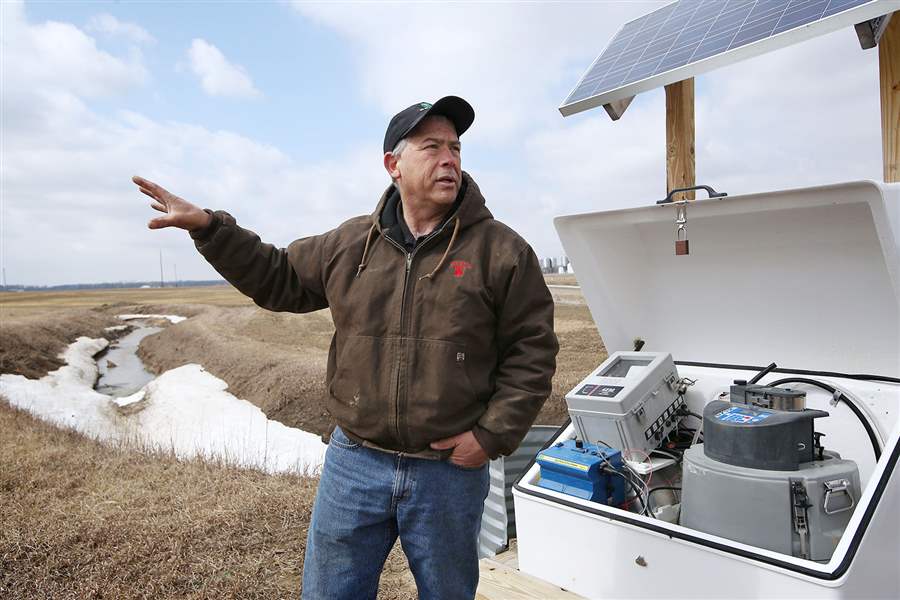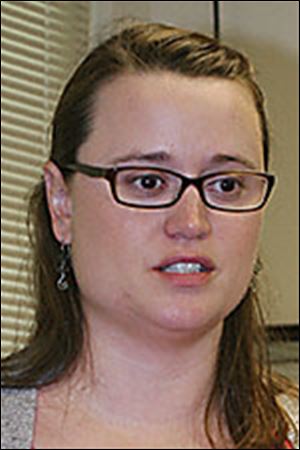
Corporate farms get blame as key water-pollution culprit
More manure detected in storm runoff
8/31/2014
Terry McClure, a fifth-generation farmer in Paulding County, is one of the few northwest Ohio farmers participating in the ‘edge-of-field’ research into the role fertilizer runoff plays in Lake Erie algae blooms.
THE BLADE
Buy This Image

Johnson
Corrected version: Lake Erie basin map has been changed to fix river labels.
Perhaps former President Theodore Roosevelt said it best when he addressed a Buffalo audience in 1910, most likely in his trademark fist-pounding, cantankerous style.
“Civilized people,” Mr. Roosevelt said, “should be able to dispose of sewage in a better way than by putting it into drinking water.”
Hailed by historians as a key ally of naturalist John Muir, the founder of the Sierra Club, during the fledgling days of the American conservation movement, Mr. Roosevelt was no doubt using that upstate New York event as his bully pulpit to campaign for better Great Lakes protections.
But what has changed in the 104 years since the horse-and-buggy era faded into the sunset, and the Great Lakes region — with its rich soil and Internet-savvy modern farming techniques — became increasingly counted on to grow food for a world of 7.2 billion people that has more than quadrupled in size from the global population of 1.75 billion in 1910?
RELATED: Stricter rules for agriculture debated
What has been done to better protect the globally significant Great Lakes — which hold 20 percent of Earth’s fresh surface water, enough to submerge the continental United States in nearly 10 feet of water — as greater pressure has been exerted on the region’s shorelines from corporate agriculture, to big-box shopping plazas, to sprawling subdivisions?
And how have those changes been affected by Earth’s steadily warming climate, which scientists believe is likely the cause of stronger, more violent thunderstorms that exacerbate agricultural runoff of all kinds, including manure generated by Concentrated Animal Feeding Operations, or CAFOs?
For starters, we have better sewage treatment.
The trade-off, though, has been more agricultural runoff.
Sewage connection
First, the sewage side of the equation.
Scientists say it’s important to recognize sewage, farm runoff, and the mix of nutrients that leach off lawns and golf courses, or flow across impervious roads and parking lots are all interconnected.
So is a tiny amount of phosphorus that falls from the sky in the form of air pollution.
Add to that whatever contribution may be coming from the Oregon-area waterfront landfill known as Facility 3, which a local sewage contractor has been using in recent years to dump sludge hauled away from Toledo’s Bayview wastewater treatment plant on North Summit Street.

Though there hasn’t been enough research done to verify if Facility 3 is leaking, a chorus of public officials — led by Toledo Mayor D. Michael Collins — have strong suspicions phosphorus from the sewage plant is flowing off that site and helping western Lake Erie’s algae grow to some degree, even if it’s a relatively small contribution. Mr. Collins recently announced he will use his power as mayor to require that the next permit the city issues for removal of sludge from the Bayview plant forbid the deposit of waste on Facility 3 — a move he says won’t solve the algal problem but should at least help put a dent in it.
Oregon activist Sandy Bihn, founder of the Lake Erie Waterkeeper environmental group, said her fear is that the political “sour grapes” surrounding the Facility 3 situation will distract officials from bigger issues at hand, such as agricultural runoff.
“All of us [in the environmental community] would agree it’s just not a big thing,” she said.
Algae doesn’t know the difference, nor does it care where phosphorus comes from.
Within a couple of years after many of today’s regulatory agencies and major environmental laws grew out of America’s first Earth Day in 1970, the Great Lakes region started getting better sewage technology.
Regulators credit the landmark 1972 federal Clean Water Act and the U.S.-Canada Great Lakes Water Quality Agreement for ushering in the modern era of sewage treatment, with much of what has been applied nationally first coming into play in the Great Lakes region.
Billions of dollars have been spent since the 1970s, and billions more are being spent to improve end-of-pipe technology for what facilities discharge under normal operating conditions.
Yet the spigot won’t be turned off until Toledo, Detroit, and other Great Lakes area communities get a better grip on sewage spills.
Officials have said that remaining work on the $521 million effort to upgrade Metro Toledo’s sewage network — called the Toledo Waterways Initiative — is a stark reminder that raw human waste continues to foul primary sources of drinking water for many of the Great Lakes region’s 40 million people, decades after Mr. Roosevelt called for that to stop.
Toledo is expected to finish its project in 2020, at which point sewage spills will occur only after major storms, not after almost every shower.
The city is, believe it or not, further ahead of other communities, such as Detroit.
Detroit’s wastewater treatment plant is the world’s third-largest sewage facility behind ones in Chicago and Boston, according to the Engineering News-Record, a construction industry magazine.

Terry McClure, a fifth-generation farmer in Paulding County, is one of the few northwest Ohio farmers participating in the ‘edge-of-field’ research into the role fertilizer runoff plays in Lake Erie algae blooms.
Detroit has been getting more attention from state and federal environmental regulators because of its size and repeated breakdowns. But even Ms. Bihn, credited by many officials for bringing the issue to their attention through an exhaustive crusade, acknowledges that facility likely is responsible for less than 5 percent of western Lake Erie’s phosphorus problem.
Laura Johnson, a Heidelberg University research scientist who oversees much of that institution’s nationally known runoff data, said the Detroit River poses a unique problem because of its hydrology.
The river’s current is so strong, and the flow is so diverted along three channels, that it’s difficult and dangerous to collect as much information as scientists would like.
Still, Ms. Johnson sees that as an area ripe for more study.
But what about the highly diffuse, so-called “nonpoint sources,” such as farms, lawns, golf courses, parking lots, and roads that allow nutrients to trickle into rivers and streams that flow into western Lake Erie?
Those pollution sources have been on the rise, partly because of climate change — although contributions from lawns have decreased because Scotts, in Marysville, Ohio, the world’s largest manufacturer of lawn-care products, removed phosphorus from its household lawn fertilizers in 2013. The Andersons has followed suit.
According to the National Oceanic and Atmospheric Administration and its affiliated agency, Ohio Sea Grant, the Midwest gets 52 percent more storms dropping 3 inches or more of rain in a 24-hour period than in the early 1960s.
Jeff Reutter, the Ohio Sea Grant and Ohio State University Stone Laboratory director, frequently makes this point to groups hearing any one of the dozens of presentations he makes each year: More than two-thirds of today’s phosphorus in western Lake Erie comes from agricultural runoff. In the 1960s, more than two-thirds of it came from poor sewage treatment.
Agriculture an issue
While people in Toledo may think of Lake Erie water quality as a sewage or factory issue, it is increasingly an agricultural land-use issue.
The Maumee River watershed — the largest and the most important for western Lake Erie — is 73 percent agricultural land, Ms. Johnson said.
Mr. Reutter and other officials have been part of a state task force studying the phosphorus problem, which — to no one’s surprise — generally has been trending upward since 1995, when the first major bloom of toxic microcystis algae was detected in western Lake Erie since the 1970s.
One exception was during the drought of 2012. That, according to Mr. Reutter, only amplifies the strong correlation between agricultural runoff and western Lake Erie algae.
In its latest report, the task force called for a 40 percent reduction in farm runoff.
Mr. Reutter said he’s not convinced that’s enough. He said the Toledo water crisis, which kept 500,000 residents from drinking tap water for three days at the beginning of this month, makes it harder for the agricultural industry to fend off stronger efforts to regulate what comes off area farms.
Terry McClure is a fifth-generation Paulding County farmer who plans to pass his large hog facilities and crop fields along to his son, Ryan. Hopefully, the property will someday pass to Mr. McClure’s grandson, Caleb, a kindergartner who’s in line to become the family’s seventh-generation farmer.
“It’s so complex. The American farmer does feed the world. Every other load of wheat and every third bushel of soybeans goes overseas,” he said. “We’re committed to keeping this land in top-notch shape for a long time.”
Mr. McClure is on the front line of the ag-runoff controversy and serves as a symbol for how it could be resolved, even though his farm is nearly a two-hour drive from the Lake Erie shoreline.
He is one of a few northwest Ohio farmers offering their sites for high-tech “edge-of-field research,” designed to better quantify which nutrients roll off the surface of farms and which ones drain through subsurface tiles.
The research is to help show what advanced farming techniques have the greatest promise for controlling runoff.
Modern farmers, he says, do not want nutrients leaching off their land.
They never have. That’s like throwing money down the drain.
Farmers join fight
Today’s farmers use Geographic Information System, or GIS, technology to better hone in on which nutrients are best needed and where.
They use cover crops such as winter plantings of radishes, to help loosen soil, keep moisture near the surface, and help water penetrate the soil.
Some install control structures, underground damming devices to hold back up to a foot of water and help keep the soil moist while reducing runoff.
They create buffer strips and plant trees as windbreaks, to help keep nutrients on their land.
Earlier this year, Ohio farmers launched the “4R” nutrient stewardship program.
It calls for fertilizer applicators to become certified, be willing to have their purchases tracked, and to adhere to these simple concepts: the right fertilizer applied at the right rate, at the right time, and in the right place.
One of Ohio’s largest environmental groups, the state chapter of the Nature Conservancy, has been engaged as a third-party auditor.
But is it enough?
Fertilizer sales have fallen steadily since the 1980s. That would suggest farmers are using less, although some probably have replaced purchases with free manure provided by livestock facilities large enough to be classified as Concentrated Animal Feeding Operations, or CAFOs, which have proliferated in the Maumee River Basin in recent years.
At the same time, the most damaging type of phosphorus to Lake Erie — dissolved reactive phosphorus — is showing up in higher concentrations in the water.
Kirk Merritt, Ohio Soybean Council executive director, said farmers understand the sense of urgency and want to do more to curb runoff — yet they also remain puzzled by the increase in dissolved reactive phosphorus mixed into the water column.
“Farmers want to be part of the solution and have been working on this for years,” Mr. Merritt said. “Farmers want to keep nutrients on their land. I think it’s equally important to understand we don’t know a lot of the answers.”
Contact Tom Henry at: thenry@theblade.com, 419-724-6079, or via Twitter @ecowriterohio.